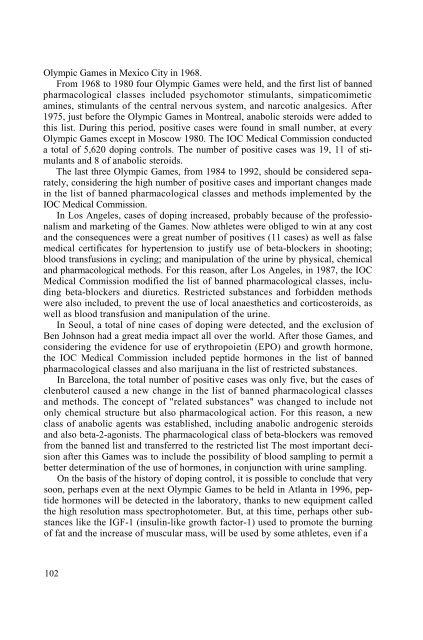Create successful ePaper yourself
Turn your PDF publications into a flip-book with our unique Google optimized e-Paper software.
Olympic Games in Mexico City in 1968.<br />
From 1968 to 1980 four Olympic Games were held, and the first list of banned<br />
pharmacological classes included psychomotor stimulants, simpaticomimetic<br />
amines, stimulants of the central nervous system, and narcotic analgesics. After<br />
1975, just before the Olympic Games in Montreal, anabolic steroids were added to<br />
this list. During this period, positive cases were found in small number, at every<br />
Olympic Games except in Moscow 1980. The IOC Medical Commission conducted<br />
a total of 5,620 doping controls. The number of positive cases was 19, 11 of stimulants<br />
and 8 of anabolic steroids.<br />
The last three Olympic Games, from 1984 to 1992, should be considered separately,<br />
considering the high number of positive cases and important changes made<br />
in the list of banned pharmacological classes and methods implemented by the<br />
IOC Medical Commission.<br />
In Los Angeles, cases of doping increased, probably because of the professionalism<br />
and marketing of the Games. Now athletes were obliged to win at any cost<br />
and the consequences were a great number of positives (11 cases) as well as false<br />
medical certificates for hypertension to justify use of beta-blockers in shooting;<br />
blood transfusions in cycling; and manipulation of the urine by physical, chemical<br />
and pharmacological methods. For this reason, after Los Angeles, in 1987, the IOC<br />
Medical Commission modified the list of banned pharmacological classes, including<br />
beta-blockers and diuretics. Restricted substances and forbidden methods<br />
were also included, to prevent the use of local anaesthetics and corticosteroids, as<br />
well as blood transfusion and manipulation of the urine.<br />
In Seoul, a total of nine cases of doping were detected, and the exclusion of<br />
Ben Johnson had a great media impact all over the world. After those Games, and<br />
considering the evidence for use of erythropoietin (EPO) and growth hormone,<br />
the IOC Medical Commission included peptide hormones in the list of banned<br />
pharmacological classes and also marijuana in the list of restricted substances.<br />
In Barcelona, the total number of positive cases was only five, but the cases of<br />
clenbuterol caused a new change in the list of banned pharmacological classes<br />
and methods. The concept of "related substances" was changed to include not<br />
only chemical structure but also pharmacological action. For this reason, a new<br />
class of anabolic agents was established, including anabolic androgenic steroids<br />
and also beta-2-agonists. The pharmacological class of beta-blockers was removed<br />
from the banned list and transferred to the restricted list The most important decision<br />
after this Games was to include the possibility of blood sampling to permit a<br />
better determination of the use of hormones, in conjunction with urine sampling.<br />
On the basis of the history of doping control, it is possible to conclude that very<br />
soon, perhaps even at the next Olympic Games to be held in Atlanta in 1996, peptide<br />
hormones will be detected in the laboratory, thanks to new equipment called<br />
the high resolution mass spectrophotometer. But, at this time, perhaps other substances<br />
like the IGF-1 (insulin-like growth factor-1) used to promote the burning<br />
of fat and the increase of muscular mass, will be used by some athletes, even if a<br />
102

















